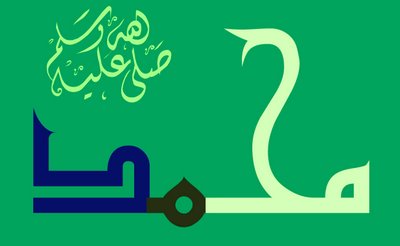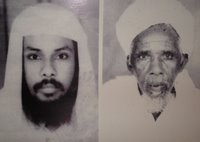His face (peace and blessings upon him)

His complexion (peace and blessings upon him) has been described as being somewhat delicately wheaten in
color or whitish with reddish tones. His face was luminous, almost round, but
not round, and frequently compared to the beauty of the full moon when it
reached its zenith.
He had a broad forehead and his eyebrows were separate and thick with
densely fine hair. When the Prophet, praise and peace be upon him, became
displeased a vein between his eyebrows became enlarged. His eyes were jetblack
and his eyelashes long, mascared with kohl made from ithmid that he
applied thrice to each eye before sleeping. Our Prophet, praise and peace be
upon him, tells us that: "... kohl made from ithmid used on the eye brightens
the eyesight. Also, it strengthens and increases the growth of the eye lashes."
His companions said that even when he did not use kohl, his eyes looked as if
he had.
His nose was prominently distinguished. His cheeks were smooth and well
covered whilst his proportionally perfect mouth was neither large nor yet
small. His teeth were bright, slim and evenly spaced, however, the space
between his front teeth was slightly larger. As for the thickness of his beard, it
was dense.
His hair was slightly wavy, sometimes it was cut short and at other times he
wore it nearly shoulder length. When his hair had the tendency to part itself
in the middle he wore it that way, otherwise he did not dress it in that fashion.
His habit was to use oil on his hair and in order not to soil his turban he
would place a piece of cloth between it and his hair. When he went on
pilgrimage to Mecca, he would shave his hair.
The Prophet, praise and peace be upon him, would dress his hair and his
beard using his right hand. It was not his practice to dress his hair every day,
in fact, he prohibited it, unless there was a valid reason, and would dress his
hair every third day.1
1. These chapters mention the Day of Judgement, the blowing of the trumpet,
hell, and its punishment. The Prophet, praise and peace be upon him, said:
"If you knew what I know, you would laugh but a little and cry a lot. You
would even stop going to your wives."
In later life, the Prophet had several silver hairs on his temples. It has been
reported that they ranged between fourteen and twenty. The accuracy of these
reports is equally valid as they came over a period of time. One day, when
Abu Bakr first noticed the silver hairs, he said: "O Messenger of Allah, you
have become old," whereupon the Prophet, praise and peace be upon him,
said: "The recitation of the chapters Hud, Waaki'ah, Mursalaat, 'Amma and
Kukkirah have made me old."
The scholars of Islam teach that this means it is prohibited at such times
when there is no need to dress one's hair. If it needs to be dressed, there is no
harm in it
It was the practice of elderly men to dye their hair before they went off to fight
to disguise their age. According to the Shafi and Hanafi schools of
jurisprudence, the Prophet, praise and peace be upon him, either forbade or
disapproved the use of a completely black dye except in war but permitted the
use of henna, which is a reddish dye, and approved its mixing with katm,
which is a black dye extracted from a certain grass. However, the katm must
be used in a lessor quantity in order that the hair does not become totally
black, rather, a darker tone of red.
Scholars are uncertain whether or nor the Prophet dyed his hair. Some say
that he did so occasionally but not regularly. The reason given for their doubt
as to whether or not he used a dye is that very often before dark hair changes color it turns reddish, therefore the reddish hair mentioned in several
Prophetic Quotations (Ahadith) could have been natural, and not a dye.



0 Comments:
Post a Comment
<< Home